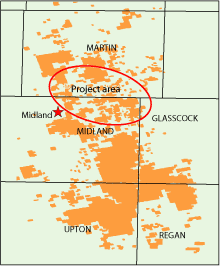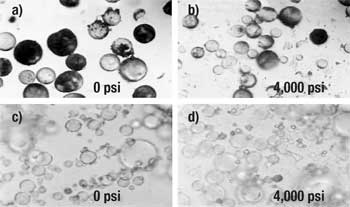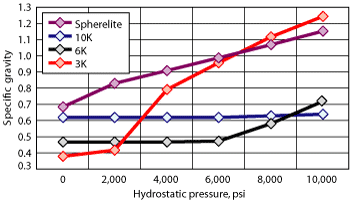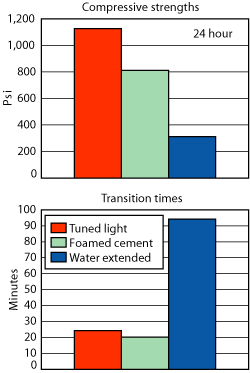Lightweight cementing seals depeleted zones
A lightweight cement lead slurry sealed underpressured reservoirs, saving up to $4 million in remedial squeezes.
A lightweight cement lead slurry sealed underpressured reservoirs, saving up to $4 million in remedial squeezes.Robert Reyes and John Brown, Halliburton; Bryan Measles, Jaime Lopez and Gerry Torres, Pioneer Natural Resources
Because of the cyclical nature of the commodity market and the constant change in commodity prices, operators must reduce the overall cost while pursuing more challenging wells. One such environment is the Wolfberry play in West Texas, Fig. 1.
Because of the rapid early production decline in these wells, they must be drilled and completed as efficiently and cost-effectively as possible. This includes drilling to total depth quickly, running affordable casing and successfully isolating zones in a severely underpressured environment. Single-stage production cementing is a must to maintain the economic viability of these wells. To maintain long-term wellbore stability, cement must be brought above the top of the Spraberry Formation (7,000–7,500 ft) from TD (9,500–10,500 ft) without fracturing the well. The Spraberry typically has a fracture gradient of 0.43–0.53 psi/ft. If the cement top is too low, one or more remedial cement jobs must be performed to isolate productive zones. Remedial cementing has an adverse effect on well economics, as well as compromising the wellbore because of squeeze perforations. Engineered solutions and application of new technology have addressed several of these issues and allowed drilling in basin areas that were previously thought to have marginal economics. BACKGROUND In the Permian Basin, cementing in the Wolfcamp/Spraberry (Wolfberry) play presents cost-conscience operators with multiple problems. The potential for high water flow from shallow formations, which tend to be corrosive, means that zonal isolation is critical. To achieve zonal isolation, the cement slurry must have a density low enough to avoid fracturing low-pressure zones, but still have enough strength for the operator to fracture stimulate all potential productive zones. This means that the cement slurry top may have to be lifted from TDs of around 10,500 ft to above the Upper Spraberry at around 7,500 ft. This must all be done within the tight economic constraints of lower producing wells. If the top of cement is not adequate, a remedial squeeze is required to isolate the uphole problem zone(s). If a proper cement top is achieved while performing a remedial squeeze, the operator still has to worry about cement invasion into the producing zone and the potential for reduced production. Both of these problems make a remedial squeeze option a less than desirable outcome. LIGHTWEIGHT CEMENT SLURRY When operating in mature Midland basins, underpressured, low-fracture-gradient reservoirs are almost a given for the majority of wells. In portions of the Wolfberry play, there are zones that are so underpressured that a mud density of 8.8–8.9 lb/gal will cause the zone to frac while drilling. This can make getting a competent cement job with proper cement tops almost impossible. The cement needs to be able to be placed from TD to above the Upper Spraberry formation in one stage and remain in place while setting. The solution on the surface is simple; just reduce slurry density. This all must be done while keeping the setting time of the placed slurry at reasonable levels to minimize contamination from produced fluids or gas and while achieving adequate compressive strengths to fracture stimulate the wells. Industry technology allows density reduction through three different mechanisms: addition of extra water, foaming the cement slurry and bulk-blending microspheres into dry cement powder.1 WATER-EXTENDED SLURRY The simplest and least expensive method of reducing slurry density is to add water. The major benefit is lower cost, since water is relatively inexpensive. While this is probably the most widely used practice, there are some downsides such as: free water, lower compressive strength development and slurry stability problems. A common misconception is that additives such as bentonite, diamataceous earth, fumed silica, potassium silicates and pozzolan are used to reduce slurry density. In actuality, these products allow us to add additional water to the slurry for density reduction and they tie up the excess or “free” water in the slurry. These slurries generally will not develop the properties to handle more difficult cementing challenges. There is also a limitation to the amount of density reduction that can be achieved before slurry stability issues arise. Using water as a lightweight additive will result in stability issues with the slurry once the density is lowered to 11 lb/gal. The reason for the popularity of this lightweight slurry is cost. Because the additive cost is low and there is an increase in yield, the slurry works well for low budget economics. Note that as it is one of the cheapest slurries, it is also the lowest in performance. Although the slurry may be attractive because of pricing, the drawback is the slurry’s slow compressive strength development and low ultimate compressive strength. Slow compressive strength development leads to excessive Waiting On Cement (WOC) times and low ultimate compressive strength. This may inhibit the required levels of long-term zonal isolation. Once zonal isolation is lost, stimulation jobs can and will go into undesired zones or, even worse, back to surface.2 FOAMED CEMENT Another option for lowering slurry density is to inject gas, most often nitrogen, into the cement resulting in a foamed slurry. The benefits include: increased elasticity of the “cured” cement,3 increased liquid slurry compressibility and the ability to easily change design density as well/job conditions change. Increased elasticity helps the cement maintain its seal in the presence of outside stresses.4 The drawback of foamed cement is additional costs. These come from computer modeling, more personnel and equipment to perform the modeling and the job, and gas pumping equipment on location. TUNED LIGHT-CEMENT SLURRY A third option for achieving lightweight cementing for oil and gas wells is by using a low-specific-gravity additive, or beads. These are microspheres that are batch mixed with the dry cement. They are available and exist as: solid, plastic beads of about 1.0 specific gravity; hollow, pozzlanic spheres of about 0.7 specific gravity and hollow glass bubbles at 0.32–0.61 specific gravity, Fig. 2.
The advantages of solid beads are their resistance to crushing under pressure and the ability to increase the elasticity of the set cement. Also, it is the only lightweight additive needed to cement from total depth to surface. The pozzlanic bead is the most popular because of the cost. However, these beads have a thin wall and trauma to the slurry will crush a large percentage of them. Bead crushing needs to be factored in on the slurry design, Fig. 3.1
All microsphere slurries have high strength-to-weight ratio and low permeability compared to other cement slurries. Another added benefit is the reduced WOC transition time from liquid to cement setting. A shorter WOC time will minimize the chance for flow path creation by wellbore fluids. This helps to ensure total isolation of the well from water/gas flow from zone to zone, Fig. 4.
CASE HISTORY Historically, Spraberry/Wolfcamp wells have been cemented with a single-stage cementing operation using the least costly cement systems possible that meet Texas Railroad Commission guidelines. Because the Spraberry Formation is typically depleted or near depletion, it is severely underpressured; thus, it has a very low density tolerance and a tendency to break down during the primary cement job. Efforts have been made for years to develop cement systems or pumping methods that allow operators to obtain cement tops above the Upper Spraberry, to isolate the formation from corrosive water zones above the Spraberry, and to allow Spraberry fracture stimulation. Methods and procedures that have been tried with mixed success include:
All of these and other methods tried achieved limited to no success. Prior to trying the new cement systems, most operators had opted for sealing the pipe with a protective coating/wrap to minimize contact with corrosive waters and pumping the standard lightweight, water-extended slurries. This met with mixed success. The life of the well has been extended due to reduced pipe corrosion, but the potential for watering out the Upper Spraberry zone is dramatically increased. Pioneer Natural Resources began tracking its cement top success rate in 2006 and showed that the rate varied across its Spraberry acreage. The company could achieve a success rate over 95% in some areas and less than 50% in others. The overall success rate was about 65%. This meant that 35% of the time engineers had to squeeze off the annulus between the Upper Spraberry and the corrosive water zones above. There was mixed success getting isolation with a single squeeze. Under the best-case scenario, engineers were able to get isolation with a single squeeze, fracture stimulate the Upper Spraberry and then put the well on production. This would cost 1–2 weeks’ delay in production and as much as $100,000–$300,000 of increase in well cost. The worst-case scenario meant that engineers had to attempt numerous squeeze jobs with no success, were unable to isolate the Upper Spraberry from potential corrosive water flows above or would not be able to complete the Upper Spraberry. So the company could not obtain the total production desired. If the Upper Spraberry could not be isolated from a potential water flow above, then engineers watched offset wells to insure that the Upper Spraberry did not “water out” and reduce production from those wells. Pioneer asked Halliburton to find a solution to this problem using their new Tuned Cement systems. After lab testing and computer simulations, a slurry system was developed at 10.2–10.5 ppg to fit the needs, Table 1. The best economic fit for the wells was to run a lead system of the 10.2–10.5-ppg slurry, followed by the standard 14.4-ppg, 50:50 (cement: pozzolan) slurry. The tail slurry was to fill up to the Lower Spraberry and the lead system would fill to 250 ft above the Upper Spraberry. This would give the well a light enough annular column to keep from breaking down the Spraberry, cement strong enough to pump fracture stimulations in all zones and a cement job that still fit within the economic constraints. Several areas were marked for this system due to the high failure to achieve adequate top of cement.
As of the October 2008, 45 cement jobs using the new system had been pumped with only nine failures (wells that did not achieve adequate top of cement). By not having to do remedial cement work on 36 wells, the company was able to save a minimum of $2 million to $4 million across the 2008 new well program. ACKNOWLEDGEMENT The authors thank Lito Perin who served as in-house support for Pioneer during the writing of this work. This article was prepared from a paper presented at the Southwest Petroleum Short Course held in Lubbock, Texas, on April 20–23, 2009. LITERATURE CITED 1 Kulakofski, D., Steele, K., Paternostro B. P. and C. T. Castille, “Lightweight cementing solutions: A novel concept utilized field case histories,” presented at Subsea Houston, Houston, Sept. 18, 2003.
|
||||||||||||||||||||||||||||||||||||||||||||||||||||||
e
Related Articles- Coiled tubing drilling’s role in the energy transition (March 2024)
- Shale technology: Bayesian variable pressure decline-curve analysis for shale gas wells (March 2024)
- Using data to create new completion efficiencies (February 2024)
- Digital tool kit enhances real-time decision-making to improve drilling efficiency and performance (February 2024)
- E&P outside the U.S. maintains a disciplined pace (February 2024)
- Prices and governmental policies combine to stymie Canadian upstream growth (February 2024)








